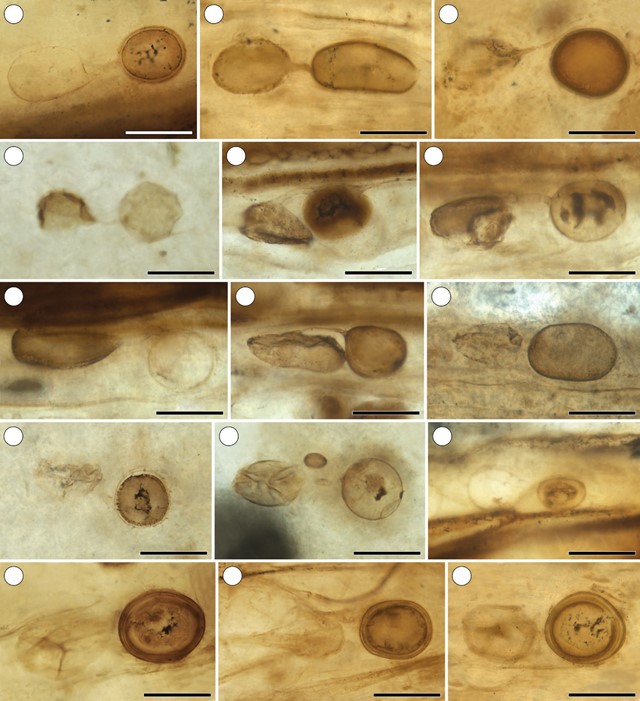Archaeosporites C. Walker, C.J. Harper et M. Krings gen. nov.
Figs 2A1,2–C1,2, 3A–O, 4A–E, G–K, 5A and 6B
Index Fungorum: IF 556488; Facesoffungi number: FoF
Etymology: The name underscores the similarity to the ex- tant genus Archaeospora; the suffix -ites (Greek: to indicate a close connection) is used to designate a fossil taxon as pro- posed by Pirozynski and Weresub (1979).
Diagnosis: Fossil propagules (acaulospores), sessile, occurring singly, forming laterally or centrally within neck of sporiferous saccule; saccule <150 µm long, formed by blastic development of hyphal tip, with thin wall of one component; acaulospores globose to ellipsoid, <100 µm in diameter; wall of two main components, outer component (saccule wall) over- lying structural wall; outer wall component sometimes overlaid by small adherent particles.
Type species: Archaeosporites rhyniensis C. Walker, C.J. Harper et M. Krings (hic designatus) sp. nov.

Fig. 2. Three types of acaulospore development in the neck of sporiferous saccule in extant and fossil specimens, each with corresponding graphical represen- tation. Extant specimen, Archaeospora ecuadoriana, W5340 (modified from Fig. 2a–c in Schüßler and Walker, 2019): (A1,2) acaulosporoid; (B1,2) ambisporoid; (C1,2) entrophosporoid. Fossil specimens, Archaeosporites rhyniensis gen. et sp. nov.: (D1,2) acaulosporoid; SNSB-BSPG 2016 XII 12 (D1 is the holotype); (E1,2) ambisporoid; SNSB-BSPG 2016 XII 24; (F1,2) entrophosporoid; SNSB-BSPG 2016 XII 12.

Fig. 3. Intraspecific morphological variability of Archaeosporites rhyniensis gen. et sp. nov.; all figures to same scale. (A) SNSB-BSPG 2016 XII 12. (B, C) SNSB-BSPG 2016 XII 13. (D–H) SNSB-BSPG 2016 XII 24. (I) SNSB-BSPG 2016 XII 31. (J, K) SNSB-BSPG 2016 XII 38. (L) SNSB-BSPG 2016 XII 39. (M, N) P3980. (O) P3981.

Fig. 4. Archaeosporites rhyniensis gen. et sp. nov. compared with extant species of Archaeosporaceae. (A and B, C and D, E and F) Acaulosporoid spores re- maining attached to an easily recognizable empty saccule (s). (A) P3980. (B) Archaeospora ecuadoriana; W5340. (C) SNSB-BSPG 2016 XII 6. (D) Archaeospora myriocarpa; W5878. (E) P3980. (F) Archaeospora trappei; W4610. (G, H) Saccules (s) lacking acaulospore development. (G) SNSB-BSPG 1965 I 350. (H) Archaeospora trappei; W4743. (I, J) Acaulospores with congealed contents. (I) SNSB-BSPG 2016 XII 6. (J) Archaeospora myriocarpa; W5878. (K, L) Entrophosporoid spores still attached to a collapsed saccule (s). (K) SNSB-BSPG 2016 XII 26. (L) Archaeospora schenckii; W4389.

Fig. 5. Comparison of acaulospore wall structure (C1–3) between fossil and extant specimens. (A) Archaeosporites rhyniensis gen. et sp. nov. with adherent debris on the outermost wall component (C1) and apparent third innermost wall component (C3); P3981. (B) Extant Archaeospora spainiae; W6437

Fig. 6. Size comparison of Rhynie chert spore–saccule complexes. (A) Example of large spore–saccule complex described by Dotzler et al. (2009); SNSB-BSPG 2013 XIV 6. (B) Archaeosporites rhyniensis gen. et sp. nov. spore–saccule complex; P3980. Arrowhead indicates saccule.
Species
